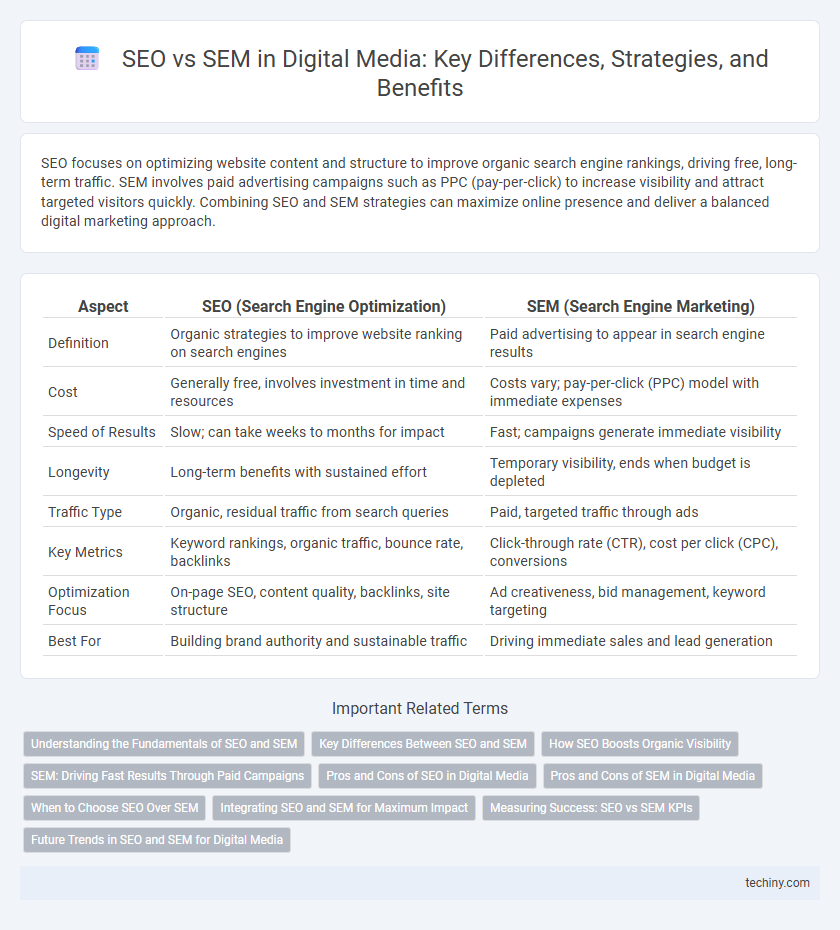SEO focuses on optimizing website content and structure to improve organic search engine rankings, driving free, long-term traffic. SEM involves paid advertising campaigns such as PPC (pay-per-click) to increase visibility and attract targeted visitors quickly. Combining SEO and SEM strategies can maximize online presence and deliver a balanced digital marketing approach.
Table of Comparison
| Aspect | SEO (Search Engine Optimization) | SEM (Search Engine Marketing) |
|---|---|---|
| Definition | Organic strategies to improve website ranking on search engines | Paid advertising to appear in search engine results |
| Cost | Generally free, involves investment in time and resources | Costs vary; pay-per-click (PPC) model with immediate expenses |
| Speed of Results | Slow; can take weeks to months for impact | Fast; campaigns generate immediate visibility |
| Longevity | Long-term benefits with sustained effort | Temporary visibility, ends when budget is depleted |
| Traffic Type | Organic, residual traffic from search queries | Paid, targeted traffic through ads |
| Key Metrics | Keyword rankings, organic traffic, bounce rate, backlinks | Click-through rate (CTR), cost per click (CPC), conversions |
| Optimization Focus | On-page SEO, content quality, backlinks, site structure | Ad creativeness, bid management, keyword targeting |
| Best For | Building brand authority and sustainable traffic | Driving immediate sales and lead generation |
Understanding the Fundamentals of SEO and SEM
SEO focuses on optimizing website content and structure to improve organic search rankings through techniques like keyword research, on-page optimization, and backlink building. SEM incorporates SEO strategies but primarily involves paid advertising campaigns such as pay-per-click (PPC) to increase visibility on search engine results pages (SERPs). Mastering both SEO and SEM fundamentals enables digital marketers to effectively drive targeted traffic, enhance online presence, and maximize return on investment (ROI).
Key Differences Between SEO and SEM
SEO focuses on optimizing website content and structure to improve organic search rankings, emphasizing keyword research, on-page optimization, and link building. SEM encompasses paid advertising strategies such as Pay-Per-Click (PPC) campaigns that target specific keywords to increase visibility instantly. The primary difference lies in SEO's long-term, cost-effective approach to gaining traffic versus SEM's immediate, budget-dependent results through paid placements.
How SEO Boosts Organic Visibility
SEO enhances organic visibility by optimizing website content, structure, and metadata to align with search engine algorithms, increasing the likelihood of ranking higher in search results. Effective keyword research and quality backlinks improve domain authority, driving sustained, cost-effective traffic without direct advertising expenses. Consistent SEO efforts foster trust and credibility with users, resulting in improved click-through rates and long-term digital presence.
SEM: Driving Fast Results Through Paid Campaigns
SEM leverages paid campaigns like PPC and display ads to drive immediate traffic and conversions, offering faster results compared to SEO's organic approach. Platforms such as Google Ads and Bing Ads enable precise targeting based on keywords, demographics, and user behavior, maximizing ROI in real-time. Effective SEM strategies combine data-driven bidding, ad copy optimization, and landing page alignment to accelerate visibility and sales growth in competitive digital markets.
Pros and Cons of SEO in Digital Media
SEO in digital media enhances organic search visibility by optimizing website content and structure, leading to sustained traffic growth without direct advertising costs. However, SEO requires significant time investment to achieve measurable results and faces challenges like algorithm updates that can impact rankings unpredictably. Unlike SEM, SEO offers long-term benefits but lacks immediate visibility and requires ongoing content and technical optimization to maintain effectiveness.
Pros and Cons of SEM in Digital Media
SEM in digital media offers rapid visibility on search engines through paid ads, driving targeted traffic almost instantly, which can boost conversions and brand awareness effectively. However, the primary downside is the ongoing cost, as campaigns require continuous investment and can become expensive without proper budget management and optimization. Unlike SEO, SEM results cease when spending stops, making it less sustainable for long-term organic growth.
When to Choose SEO Over SEM
Choose SEO over SEM when aiming for sustainable, long-term organic traffic growth with a limited budget. SEO enhances website credibility and user experience through optimized content, metadata, and site structure, which improves search engine rankings naturally. Opt for SEO if your priority is building brand authority and maintaining consistent visibility without ongoing advertising costs.
Integrating SEO and SEM for Maximum Impact
Integrating SEO and SEM leverages organic search tactics alongside paid advertising to maximize online visibility and traffic. Combining keyword optimization and quality content with targeted PPC campaigns enhances both short-term performance and long-term authority on search engines. This unified strategy improves ROI by balancing cost-effective organic growth with precision-driven paid promotion.
Measuring Success: SEO vs SEM KPIs
SEO success is primarily measured through organic traffic growth, keyword rankings, and domain authority, reflecting long-term visibility and credibility in search engines. SEM focuses on immediate performance indicators such as click-through rates (CTR), conversion rates, cost per click (CPC), and return on ad spend (ROAS) to evaluate paid campaign effectiveness. Comparing SEO and SEM KPIs highlights SEO's emphasis on sustained organic growth, while SEM prioritizes direct, quantifiable advertising outcomes.
Future Trends in SEO and SEM for Digital Media
Future trends in SEO and SEM for digital media emphasize AI-driven algorithms and voice search optimization, transforming keyword strategies and content creation. Integration of machine learning enhances personalized ad targeting in SEM, while SEO evolves with semantic search and structured data to improve organic visibility. Augmented reality and video content are increasingly prioritized, shaping the future landscape of digital media marketing.
SEO (Search Engine Optimization) vs SEM (Search Engine Marketing) Infographic

 techiny.com
techiny.com